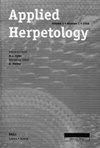First record of Osteopilus septentrionalis on Guana Island, British Virgin Islands
引用次数: 3
Abstract
Cuban treefrogs are native to Cuba, the Cayman Islands, and the Bahamas, but are increasingly recorded from other locations (Lever, 2003). The species was first collected in the British Virgin Islands (BVI) in 1990 (Owen et al., 2005) and has since spread, with about one new island record per year in the BVI (Owen et al., 2005, 2006; Perry and Gerber, 2006) and new localities in the United States Virgin Islands (Waddle et al., 2005; Platenberg and Boulon, 2006; Perry and Platenberg, 2007). Perry and Gerber (2006) mentioned that the species had been sighted on Guana Island, BVI, but did not provide any information that would allow the significance or circumstances of the event to be evaluated. Those details are provided herein. At about 2000 h on 21 October 2005, I collected an adult male (SVL = 72 mm) with small nuptial pads, foraging at a night light within the hotel complex on Guana Island. Guana Island is a private wildlife preserve. In the 12 months prior to the reported event, the small hotel on the island had imported relatively large quantities of construction materials and ornamental plants. However, hotel staff had made extensive attempts to prevent the arrival of the Cuban treefrog and other invasive species. These include manual searches of all arriving plants and other materials while still on the barges bringing them to the island, and on-island fumigation within an enclosure into which arriving materials and engine exhaust were introduced (Perry et al., 2006). No additional Cuban treefrogs have been seen on Guana since removal of that individual, despite extensive searches in 2006 and 2007. Guana Island offers RA P.1 (1-2) APHE:m v 1.24 Prn:7/01/2009; 14:03 aphe1161 by:Daiva p. 1英属维尔京群岛瓜那岛首次记录的七爪骨猿
古巴树蛙原产于古巴、开曼群岛和巴哈马群岛,但越来越多的记录来自其他地方(Lever, 2003)。该物种于1990年首次在英属维尔京群岛(BVI)被收集(Owen et al., 2005),此后开始扩散,在英属维尔京群岛每年约有一个新的岛屿记录(Owen et al., 2005, 2006;Perry和Gerber, 2006)以及美属维尔京群岛的新地区(Waddle等人,2005;Platenberg and Boulon, 2006;Perry和Platenberg, 2007)。Perry和Gerber(2006)提到该物种曾在英属维尔京群岛瓜纳岛被发现,但没有提供任何信息来评估该事件的重要性或环境。这些细节在此提供。2005年10月21日约2000时,我在瓜纳岛酒店群的夜间灯光下采集了一只成年雄性(SVL = 72毫米)和小婚垫。瓜纳岛是一个私人野生动物保护区。在报告事件发生前的12个月里,岛上的小酒店进口了大量的建筑材料和观赏植物。然而,旅馆工作人员曾多次试图阻止古巴树蛙和其他入侵物种的到来。这些措施包括在将所有到达的植物和其他材料运至岛屿的驳船上进行人工搜索,以及在将到达的材料和发动机废气引入的围栏内进行岛上熏蒸(Perry et al., 2006)。尽管在2006年和2007年进行了广泛的搜查,但自从那只古巴树蛙被移走后,在瓜纳没有看到更多的古巴树蛙。瓜纳岛提供RA P.1 (1-2) APHE:m v 1.24 Prn:7/01/2009;[14:03] [au:] [au:
本文章由计算机程序翻译,如有差异,请以英文原文为准。
求助全文
约1分钟内获得全文
求助全文

 求助内容:
求助内容: 应助结果提醒方式:
应助结果提醒方式:


